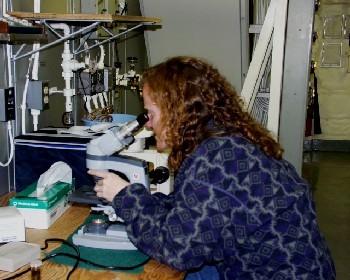
|
|
26 June, 2000
26 June 2000
My Name Is Mud
When Dr. Lisa Clough steps on a research ship, word quickly gets around
that the “Mud Lady” is on board. Dr. Clough relishes playing in the muck
that covers the bottom of the ocean and houses the critters that draw her
interest. Her enthusiasm is contagious and a dredge or box core will get
the deck crew looking through the mud - usually on the deck, but sometimes
through mud covered eyes or glasses. Once the samples are collected and set
aside, all’s fair in mud and war with any of the material left over. The
key strategy in a mud fight according to Lisa is to go for the sunglasses -
by the time they’ve cleared enough to see, you’ve gained the upper hand(fuls
of mud)!
See, research can be fun! Once the mud has been hosed off people and the
deck with fire hoses, what does Dr. Clough find in the samples set aside
before the mayhem? In a word “worms”, in several words “head-down
deposit-feeding capitellid polychaete worms”. Polychaetes are segmented
marine worms in the same phylum, Annelida, as earthworms. This type of
polychaete feeds on materials deposited in the seafloor with its head down
in the sediments and its posterior end near the surface of the sediments.
It takes some looking to find them, as they are only 5cm long and 2mm in
diameter. As Lisa puts it, “They look like red threads”.
What is so special about these parcticular worms? They live in an
environment that would kill most living organisms other than certain types
of bacteria. Not only do they live in an environment with very limited
oxygen availability, the sediment layers they are feeding in are very high
in sulfides which themselves are often fatal to animals that require oxygen
for cellular respiration. The type of sulfides the worms are exposed to
bind with hemoglobin and block processes in the mitochondria. Hemoglobin is
found in the worm’s blood and binds with oxygen to carry it through the body
much as it does in humans. When the oxygen reaches mitochondria in the
cells, it is used to help break down carbohydrates in the process of
cellular respiration, resulting in the production of energy the body can use
(in the form of ATP). Sulfides can block both these processes, killing most
animals. Many people are familiar with the presence of sulfides in
sediments. If you have ever stepped in mud that generated a smell of rotten
eggs, you’ve released sulfides trapped in the sediments. In high
concentrations, these chemicals can quickly overpower your sense receptors
to them and then overpower you!
Other organisms live in areas of high sulfide concentrations, but these are
near hydrothermal vents near spreading zones, and they have symbiotic
bacteria living within them. The famous giant tubeworms (Riftia) of vent
communities survive because they have specialized hemoglobin and bacteria
living within them that process the potentially toxic sulfides and generate
energy for themselves and the tubeworms. The worms Dr. Clough studies don’t
appear to have any such assistance. They have evolved chemical processes
and behaviors that allow them to survive, and thrive, in this typically
lethal environment. In doing so, they are reclaiming some of the energy not
claimed in this habitat by the sulfur reducing bacteria that also live in
those sediments.
In addition to the worms she studies in hypoxic (low oxygen) and anoxic (no
oxygen) environments, the Mud Lady has two other research interests. One of
these is the ecology of man-made environments such as the wetland habitats
mining companies create in her area to replace habitats altered by their
operations. Dr. Clough can compare their community and energetic structure
with those of natural wetlands of the area, and it gives her hands-on
activities for her undergraduate students at East Carolina University in
Greenville, North Carolina. Lisa is an Assistant Professor in the
Department of Biology at ECU. She started there as a post-doctoral student
after completing her PhD at SUNY at Stony Brook.
Her other research interest is the Arctic, and this is where USCGC Healy
comes in. The ship will allow her and other researchers to fill in gaps in
our understanding of the processes that take place during the year in the
Arctic. Until the HEALY was built, U.S. researchers couldn’t get very far
into arctic waters for most of the year. This limited access meant they
couldn’t study what happens in the ecosystem for nearly ten months out of
the year. Now Dr. Clough can try to answer such questions as “What is the
role of ice algae in the Arctic?” and “What happens to Arctic marine systems
during the period when the sun isn’t shining during the months-long arctic
night of northern polar winter?” USCGC Healy will be the tool that the Mud
Lady and others can use to reach those environments in order to unlock the
secrets hiding under the icepack of the seas of the Arctic Ocean.

Dr. Clough taking a look at ice algae samples. (photo by Todd)

Dr. Lisa Clough - The Mud Lady
Contact the TEA in the field at
.
If you cannot connect through your browser, copy the
TEA's e-mail address in the "To:" line of
your favorite e-mail package.
|
